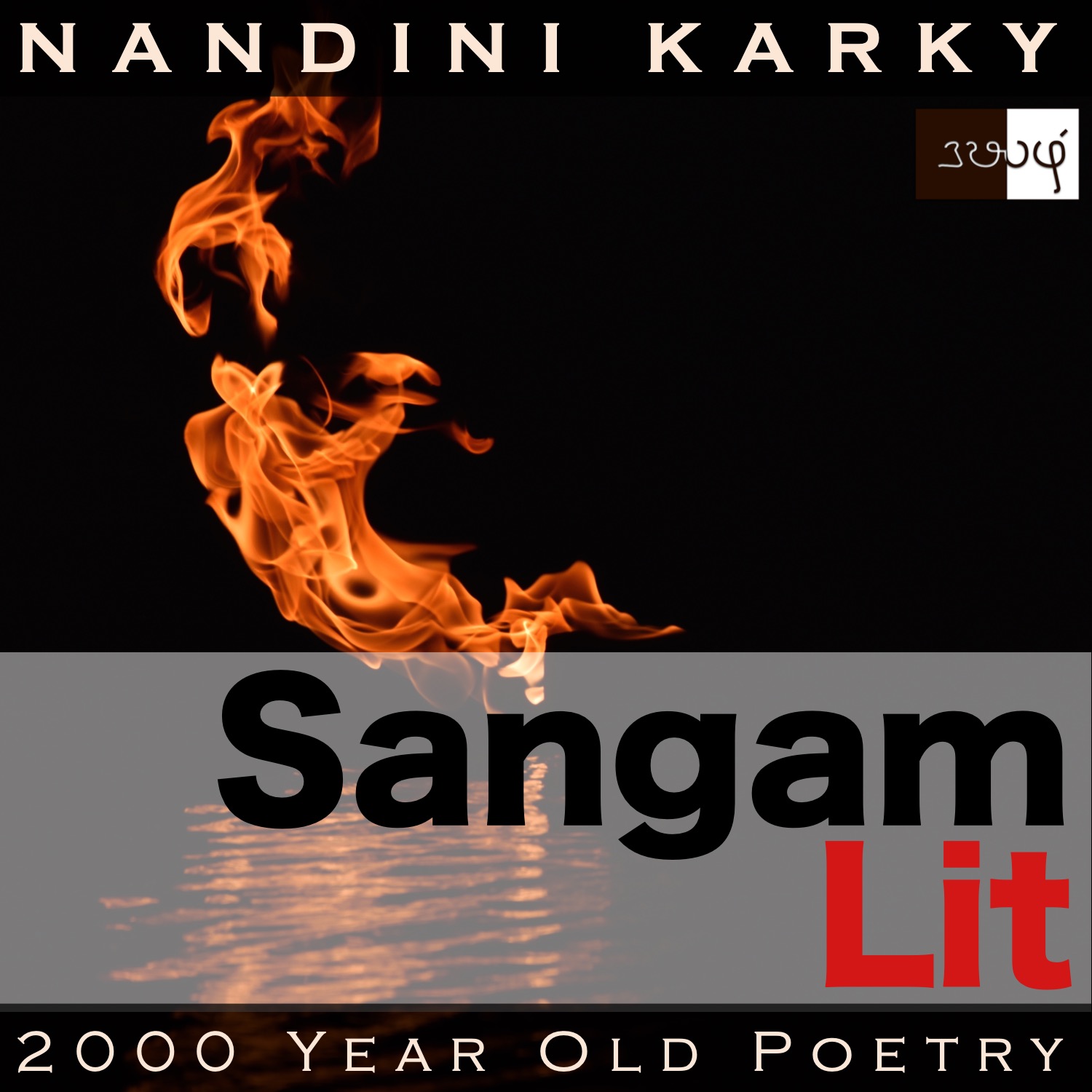Podcast: Play in new window | Download
Subscribe: Apple Podcasts | Spotify | Amazon Music | Android | iHeartRadio | TuneIn | RSS | More

In this episode, we relish the contrasting imagery to paint the emotions in parting, as depicted in Sangam literary work, Natrinai 177, penned by an anonymous poet. The verse is set in the ‘Paalai’ landscape or drylands and speaks in the voice of the lady to the confidante, expressing her discovery of the man’s intention to part away.
பரந்து படு கூர் எரி கானம் நைப்ப,
மரம் தீயுற்ற மகிழ் தலைஅம் காட்டு
ஒதுக்கு அரும் வெஞ் சுரம் இறந்தனர் மற்றவர்
குறிப்பின் கண்டிசின் யானே; நெறிப் பட,
வேலும் இலங்கு இலை துடைப்ப; பலகையும்
பீலி சூட்டி மணி அணிபவ்வே;
பண்டினும் நனி பல அளிப்ப; இனியே
வந்தன்று போலும்-தோழி!-நொந்து நொந்து,
எழுது எழில் உண்கண் பாவை
அழிதரு வெள்ளம் நீந்தும் நாளே.
The poem opens evoking the image of a wild fire with the words ‘பரந்து படு கூர் எரி’ meaning ‘spreading wide and burning high’. The connected phrase ‘மகிழ் தலைஅம் காட்டு’ talks about a ‘forest, shorn of its joy’, expressing the ruin of trees, with poetic glory. ‘குறிப்பின் கண்டிசின்’ talks about the intricate technique of ‘seeing through another’s gestures and expressions’ without any words whatsoever. Observing ‘பலகை’, immediately brought forth the image of a carpenter’s ‘plank’, the current-day meaning of the word. However, here it turns out to be something like a soldier’s shield! And these shields are ‘being decorated with peacock feathers and bells’ as the phrase ‘பீலி சூட்டி மணி அணிபவ்வே’ informs us! Shields with feathers – Does that ring a bell? Let’s explore that, a little later. The word ‘நொந்து’ means ‘to suffer’ and it occurs in the rhythmic phrase ‘நொந்து நொந்து’, resounding with the pain of the lady’s suffering.
The man and lady had been leading a happy married life, when the lady found herself worried about something that was about to happen. She turns to her confidante and says, “As the raging fire sets the trees aflame, the forest is shorn of all happiness. To the difficult path through such a forest in the hot drylands, my man has decided to leave. I have discovered this, seeing his actions. For, he is occupied with wiping the leaf-like ends of his spear and with tying peacock feathers and bells to his shield, that he plans to take along, through the drylands path. Also, he showers love on me like never before. Looks like it has arrived, my friend! The day I suffer and suffer, making the pupils in my kohl-streaked, beautiful eyes swim in the ceaseless flood of tears!” With these words, the lady expresses how she has discovered that the man intends to part away and confides her pain at the thought of that happening.
Now, to explore the images in this poem at a greater depth. The poem opens with the urgency of a forest fire. The flames soar to the skies and spread as far as the eyes extend. And, the trees, unable to bear the assault, perish in the blaze. That determines the joyless fate of the forest, the lady says. She depicts this scene to say, she surmises that the man intends to leave on a treacherous path through such a forest. And, how does she know? Did the man tell her? Seems like, no words are necessary between them. She has been observing his silent actions. He seems to be intent on cleaning the clover-shaped ends of his spear and also, decorating his shield with peacock feathers and bells. As if these actions were not enough, the man also seems to be showering the lady with profuse love. Much more than before, the lady adds! Seeing all this, she decides that the only reason is that the man has decided to part with her and journey through those burning drylands.
The lady concludes by saying, if this is so, the moment of ruin has arrived for her. The moment, when she would find the pupils of her eyes, swimming in an overwhelming flood of tears. The lady balances the flare in the beginning with the flood in the end, rendering it with the beauty of symmetry. Returning to that image of a shield decorated with feathers, I tried to search for instances of this, in ancient Indian shields but, what I stumbled upon was, another kind of ‘Indian’ shield, belonging to the ‘Native Americans’ or ‘Red Indians’ as they have been referred to. Intriguing that this nuanced element of Sangam life finds an echo 15,000 kilometres away, in another ancient culture! We may not possess the eyes to accurately see the truth behind this connection but we do have the hearts to see that in the end, no matter the colour of the skin, or the place of origin, we are all one!




தென்னமெரிக்க தொல்குடியினர் மாயன் நாகரீகம் குமரிக்கண்ட தமிழ் தொல்குடியினர் இடையே தொடர்பு உண்டு எனும் கருத்து உண்டு